#through the lens of attachment to certain characters and how well stories appeal to that or not
Photo

Armie Hammer wants a sequel to The Man From U.N.C.L.E.—shouldn’t you?
This post is a long time in coming, Gentle Readers and @jammeke, but now, though it might be here, before your very eyes, to think it will be well-laid out would be a mistake. It’s set to be just about as messy as Ilya’s misplaced loyalties and murky motivations.

How dare!
I probably first watched this film well over a year ago (courtesy @jammeke posting things about it). I used Sling OnDemand (I think on TNT). In the ensuing viewings I also watched it in that way, but as I was sitting down for a fourth(?) viewing, it kept coming to me that I was tired of watching it with commercials I couldn’t skip, and I had a sneaking suspicion that it had been edited for time and I was missing out on scenes. [pointless aside: I was also watching the film in chunks, and never as a whole]

Where is she now? What’s the time stamp? How far along did she get? Are you shagging the hotel hostess yet?
So, I, uh, set out to buy it on DVD—without any luck! In the sense that copies I could find cost more (w/ shipping) than buying it to stream. So, I bought it to stream on Amazon. Do I regret my choice, Gentle Readers? No, no I don’t. I do regret burden of knowledge in learning that TNT was already playing the entirety of the film. That was a hard pill to swallow.

Nope, I’ve looked. That’s absolutely everything. Nothing additional lurking around here...
So here it is, as it is, @jammeke, “My Notes on The Man from U.N.C.L.E.”

Look, I don’t know what this film is. I probably can’t fully articulate its appeal. Or maybe I can--certainly after transcribing four page I’ve tried. Number One thing to know about me and fiction/films is that a top draw for me is seeing something out of the ordinary, such as beautiful locations, a historical era, delicious costumes. There are times, frankly, this can trump weak story and undefined character for me. (The best films, of course, combine all three) Certainly, The Man... delivers in the delight of the eyes. Additionally, I must confess that growing up as a person older than @reblogginhood but younger than Miss Fisher, so much of what was on TV was essentially reruns of this film’s iconic Look(tm). So, when I see women dressed like Gaby I am just another three-to-seven-year-old overcome with the drop dead glamour of it all.

Darling, tell me how you really feel...
Some questions I have:
· IS Armie Hammer a hulk of a man? Everyone in this film seems to think so, yet he always tracks to me as trim (rather than hulking)
· Why translate via captions some Russian speaking, but not all?
· IS Napoleon’s backstory directly cribbed from USA’s White Collar?
· DOES Gaby have a German accent?
· Does Ilya get preternaturally attached to all the people he’s ordered to look after? Also, what is his bonding rate with kittens?
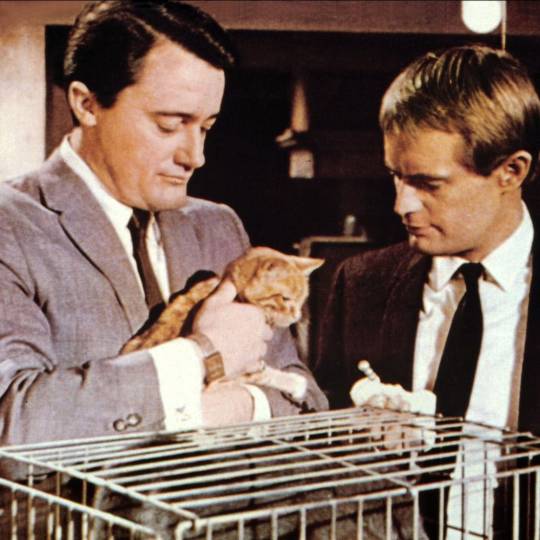
Sorry, wrong iteration.
· If Lady Villain knows the lens is wrong—if her technical understanding is that in-depth--does she really need Gaby’s dad to make the bomb?
· How old was Gaby during the war?
· What happens when Ilya gets a NEW puppy assigned to him? (please let this be addressed in film #2)
Hooray for:
· That bathroom fight! *all the Burn Notice feels!
· Gaby is her own lady, and chooses sides as necessary—not always unilateral in her support for either male character. Case in point: she sides with Ilya over the clothes, and Napoleon over the incident of the wallet.
· That delicious (speaking as Rusty, here) Ocean’s 11-stylized action. It’s pretty, so I’m not bored with it. Sometimes a sandwiched montage gets shown, so I’m REALLY not bored. I’ve got 18 tiny moving boxes of things to look at!
· Pinkie rings. There, you’ve told me everything I need to know about that character.
· Solo in a beret. English has not yet found a word for the feeling it evoked in this viewer. Somewhere between ‘precious’ and ‘oh, no’.
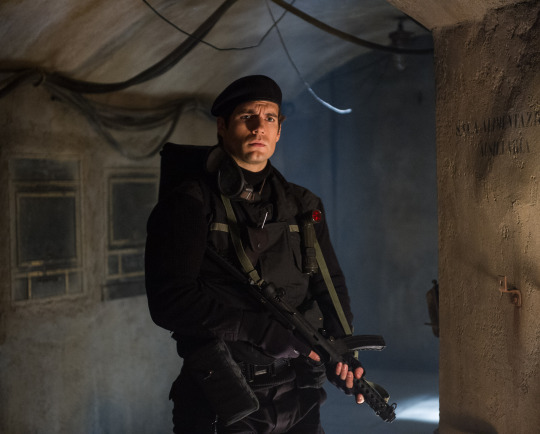
See, there? Now you’ve felt it too.
· Goggles! All the accessories! Dune Buggies! (I mean, that’s what I’m calling Napoleon’s chase-scene ride)

Things I adore:
· It seems (after some research) that more than a few folks view Gaby as a third wheel, and though she’s not exactly a Princess Leia commandeering her own rescue and exuding competence and a deserved take-charge-attitude at every corner, she IS a foci for both male characters (though romantically it would seem only for one), just as Ilya is a foci for both her and Napoleon [no one seems to worry about Napoleon, though they should--film #2, anyone?]
· Mechanic Gaby not needing a beauty makeover, or being dragged into one. She gets some nice clothes, but it’s never suggested that she’s not attractive or acceptable before putting them on, and I respect, nay, embrace it.
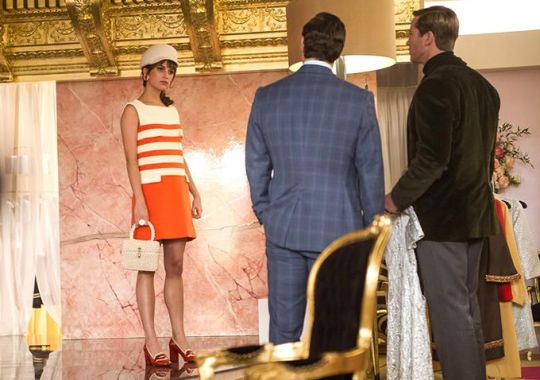
Oh, my heart. She’s still not as tall as them!
· Ilya, drab pigeon Ilya, knowing fashion
· Oh man, don’t even get me started on the power of the statement, “it doesn’t have to match”
· You knew it was coming on this sublist: the wrestle-fight. I mean, c’mon. Poor little Gaby, locked behind the Iron Curtain, living a life of always being watched. She’s in the swankest hotel (I mean, Napoleon chose it, so we can be sure it’s swank with an E). She’s trying to celebrate her freedom, her liberation. She’s playing verboten music, she’s drinking to excess. Girl wants—and deserves—a party. And Ilya is…not built for that (that he knows of). For some fun, just imagine if she had been given Napoleon to room with instead.
o I will say that this scene, and some of their other interactions have what I would call early (non-sibling) Luke and Leia energy. Ilya seems to have moments of being struck by Gaby in a way Luke is struck by Leia in the early part of the trilogy. When Leia takes charge, and Luke accepts it. When Leia does something incredible, and Luke is left open-mouthed. *no, I don’t see OT Star Wars in everything. Shut up.
· “He fixed the glitch.”
· Again, shout-out to the non-action action.
· “I left my jacket in there.”
· The whole race to rescue Gaby I am in love with beyond words. [I have noted it as “Crazy Jeep Drive with Warhead!”] Probably b/c it comes across as totally egalitarian. Both men want her rescued. They’re no longer in competition. It’s just as important to Napoleon as it is to Ilya to catch up to her. Also, it is bonkers, like some sort of X-games version of a commercial for the vehicles they’re driving. And screaming Willie Scott does not make an appearance.
Someone says “winkle” out.
· Look! Another note about the screen divisions and how I love it, shout-outs to the original Steve McQueen The Thomas Crown Affair (a contemporary of when this movie is meant to be set), and TV’s 24.

Things that get a great, big NOPE:
· Jerrod Harris: you’ve been in so much streamable content in the last decade I can’t hate you, but frankly, you’re terrible here—unless you’re supposed to be giving a mannered, not-campy-enough-to-be-enjoyable performance here. Your American English puts me in the mind of Alex Hawaii 5-0′Loughlin where it feels you’re concentrating so hard on your accent that you fail to convince anyone that you’re a harried, over-worked and exasperated spy handler. Your performance is at odds with every bit of dialogue you’re given to say.
· That awful, mishandled title that doesn’t even connect to the film until the final moments (a sequel set-up, for sure)
· Look, you don’t introduce Hugh Grant casually mid-way through your film in a throwaway appearance. I mean, he’s HUGH GRANT we all know something’s up now.
· This is not exactly a great big NOPE, b/c I love a flat cap, Tommy Shelby—but I feel like a less tall man with a far rounder face in a flat cap would track more as Russian to me that AH does. To me, he just looks like he’s about to go golfing.

Over par? Unacceptable!
· Is Victoria a British-accented Italian? A British woman who married—what? Gaby’s uncle isn’t Italian!? An Italian who went to school in Britain? My head hurts. Also, is her hair meant to be unconvincingly bleached?
Other commentary:
· Napoleon’s adult ne’er-do-well backstory is so far from being emotionally equivalent to Ilya’s childhood trauma [and his enslavement to the USSR] it seems bestial when he calls it out on multiple occasions. Badly done, Solo.

· Gaby is the film’s key (sorry, Buffy fans). Everyone is connected to her. Yes, she could have been given a bit more on the character front, but I don’t see her as as much of a flaw in the film as some others/reviewers seem to.
· Look, essentially (and not very nuanced-ly), Ilya is a stalker. I think the film goes a certain distance in establishing that his early behavior toward Gaby is not normal, but concurrently it does not truly call him out on it. He’s essentially viewed as an odd-duck, sure, but not a true threat to her (should she not reciprocate or tolerate his intensity toward her). I think I might be able to cite his behavior when Gaby comes on to him (that he doesn’t jump at a chance with her) that maybe he’s given a little more nuance than a straight-on stalker, and it helps that he and Napoleon never get into a pissing match over Gaby’s person, only over her new clothes. But overall the film has to walk a fine line (and the jury is still out on how successful it is, I’d say) between playing Ilya’s laser-like attention to Gaby for its humor, and calling it out for the unsettling, threatening behavior it is.

· Honestly, it wasn’t until I engaged the Closed Captioning that I understood Napoleon was calling Ilya the ‘Red Peril’. So, that was nearly three viewings in.
· I give the screen credits A+, on both ends. Not to mention the end credits are actually INTERESTING with lots to see and learn! (Certainly we learn more about HG in them than we do at any time during the film)
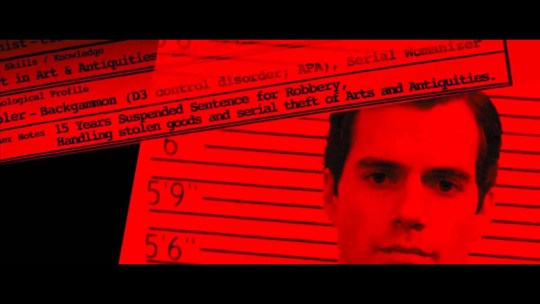
Things I would have liked:
· More of fish-out-of-the-Iron-Curtain Gaby moments
· A better dichotomy shown of East vs. West Berlin/Germany. There’s nothing easy either visually or otherwise to distinguish the two.
· HC being given a more specific American accent (from an actual locality). This, for an American viewer, works better than the flat, unlocated American accent many a British actor will bust out. *Mind you, HC does a generally good job, but he fails utterly on both “Immediate” which he pronounces at least twice as “immeedeejt” [rather than imm-E-deeot] and “Nazi” as “NAHT-zee” [rather than “NOT-zee”]. And let’s not get started on that late in the film use of ‘earnt’, a word that—well, it’s just not in the American English twentieth century lexicon.
· C’mon. You gotta tease the Hugh Grant more.
· Solo is a blank before the war. I’ve read thoughts on the film calling out Gaby as the blank character, but they’re wrong. Solo is the blank. He’s the ‘made’ man, his identity seemingly assembled during the war and after. For example, he doesn’t go into the war a thief, nor (it would seem) a particularly educated or urbane individual. Now THAT’s a juicy backstory I’d love to learn about, perhaps in film #2--or #3? What creates a Napoleon Solo? What would he be doing if he weren’t on the government’s leash/incarcerated? Is anyone left caring about him back wherever he calls home? I mean, who doesn’t love a gender-flipped 60s-era Holly Golightly backstory? [And yes, I would love there to be an ex-wife or even a current wife mixed up in his origins as well—Guy Ritchie, call me!]
Notes I have that I’m not sure if they still make sense to me:
· Only mom calls me Napoleon (do he say it ‘mum’?) Is he a secret Canadian?
· Solo’s torture, 1st view recall Napoleon’s childhood? *I think this means that after watching the first time I somehow erroneously believed that during the torture Napoleon’s childhood was a topic gone over. This was wrong. HOWEVER, this would have made far more story-sense than the backstory we’re given on an easily disposeable villain.
· “Even the average Russian agent. You’re special.” ?
· Uncle is Baddie (*so glad I made this note to myself)
· Ilya’s dad IS an embarrassment. I’m not sure what genius commentary I had in my mind, here. Perhaps that Ilya himself is embarrassed of him? Not just Ilya’s handler’s? [Also, aside: Napoleon totally slut-shames Ilya’s mom, which is the doublest of double standards from ‘I got myself the biggest and most ornate suite b/c I-wanted-plenty-of-space-for-my-random-seductions’ and I really wish Ilya had thrown that back in his face] *yes, of course I know that Ilya and Napoleon would not likely equate a wife/mother’s sexual exploits with that of Solo’s, but let’s be honest, this film tweaks the nose of (I won’t say reverses, it doesn’t go that far) plenty of tropes and gender expectations, and this certainly seems like a missed opportunity to call Solo on the carpet (which I hope film #2 does far more)
Things I wrote down so long ago I don’t recall what they mean:
· CC-save
In conclusion:
What does film #2 look like? What title does it get? Will the Peter/Neil White Collar dynamic continue to grow? *note that I have no confidence a second film will ever come to pass...
In the end, all I know is, “It didn't help when American Tom Cruise, who was slated to play U.S. spy Napoleon Solo, dropped out, prompting the casting of Cavill (who had previously read for the Russian role).“ I would not have watched that film.
#tmfu#tmfu 2015#ilya kuryakin#napoleon solo#gaby teller#henry cavill#armie hammer#alicia vikander#the man from uncle 2015#the man from u.n.c.l.e.#the man from uncle#i don't know what this film's tags are meant to be to keep it from popping up in the TV series searches Sorry
21 notes
·
View notes
Text
INTERVIEW: Star Wars Visions Producers on Letting Anime Creators Run Wild

Today marks the launch of Star Wars: Visions, an ambitious anthology project that enlists top talent and renowned studios from the anime industry and gives them the keys to the Falcon. Okay, no one's getting the keys to the Falcon per se, but while they weren't told to take the reins of established characters, studios ranging from TRIGGER (PROMARE) to Production I.G and beyond were given an immense amount of freedom to explore the types of Star Wars stories they've always wanted to tell.
You can see the results for yourself starting today on Disney+. We took an early look at all nine episodes—which run the gamut, telling tales of masterless Jedi, battling bands, and lots and lots of Kyber crystals—and then spoke to executive producer James Waugh and producer Kanako Shirasaki to break down what makes this project work.

The studio lineup is full of heavy hitters of the anime industry. I'd love to know more about how that selection was handled, and if you were reaching out to specific studios from the beginning.
James Waugh: We identified very quickly studios that we wanted to find ways to partner with. I mean, we've been a fan of so many of these studios; Production I.G, TRIGGER, on and on. Science SARU has been such a surprising influence of late, and we knew that we wanted to make sure that the anthology really showcased all the different styles of anime, and different types of creators telling stories in Japanese animation.
So we were very deliberate in selecting studios we were hoping to work with. We didn't know how it was gonna go, though. We didn't know who would be interested in Star Wars!
Turns out everyone.
James Waugh: Turns out, yeah.
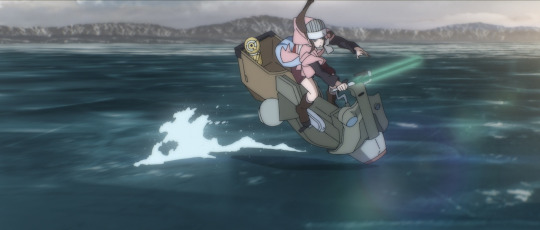
Were there any dream collaborations you can mention that didn't quite pan out for this particular project?
James Waugh: I don't think so.
Kanako Shirasaki: Yeah, I don't think so.
James Waugh: I think we were very fortunate that the studios we were interested in pursuing were interested in us, too. Suddenly, when we would take meetings with them, there was always a story about how Star Wars set them off on their journey of becoming world builders and animators and storytellers. So they were fans right from the start, and the feeling was mutual.
Kanako Shirasaki: Even the directors who didn't really talk about how much they love Star Wars, eventually they'd start talking about this and that, like little tiny episodes of their Star Wars chapter in their lifetime, so it's great to know how Star Wars influenced the lens of animators and creators.
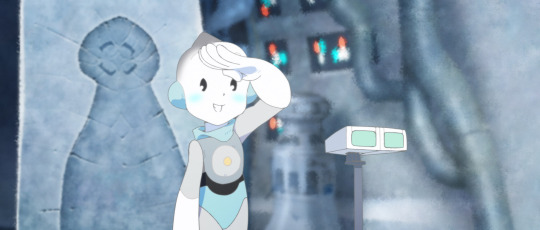
There's a lot of variety in these shorts. What was the story pitching process like as far as each episode is concerned?
James Waugh: We had a framework, a very kind of loose framework for what we wanted Star Wars: Visions to be, which was really a way to unlock timeline-focused development and allow for different creators to celebrate Star Wars through their unique lens and through a medium that, you know, is very specific and has a certain kind of vocabulary to it.
I think the only real rule we had with it was to render your own stories, your own characters. What we didn't want this to do was become like a "What If" show, which is great for Marvel, but that's not what we were trying to achieve here; it wasn't let's do a 'What if Luke Skywalker did this, or what if Darth Vader..." I love those comics, they're great, but that's not what the intention was. The intention was let's go to these creators and say, what amazing stories do you have to tell that take place in this massive galaxy... (laughs) That clearly a bazillion stories could take place in. That's really the way it works.
Then Kanako, you guys were directly engaged with the studios for the process.
Kanako Shirasaki: Yeah, and I think it worked very well, too, otherwise we couldn't have this diversity and stories from seven different studios and nine different directors. So it really worked well, and each director wanted to tell their visions in the anthology, too, so I think the framework worked nicely.
Speaking of that framework, I noticed a lot of the stories—I don't know how intentional this is—feel like they have a thematic throughline, specifically because there are a lot of Kyber crystals here. You don't really see the inner functionality of a lightsaber shown or discussed that much throughout the main saga. Was it a coincidence that a lot of the creators wanted to tackle this subject?
James Waugh: It really was. We had the same reaction, and we've been hearing that from a lot of other interviewers saying they noticed that throughline. And no, we were very much empowering them to tell the stories they wanted to tell, and I think when you look at Star Wars elements that look like they're fun to play with, and to be used in a dramatic way, I think lightsabers, Kyber crystals, these things are something creators are drawn to.
Kanako Shirasaki: Also Japanese anime, or Japanese storytelling in general, when you have some props, you want to show how they work. How the machines transform into different shapes and so on. Maybe that influenced the creators to show how you put the Kyber crystals in the lightsaber or show other things using props.
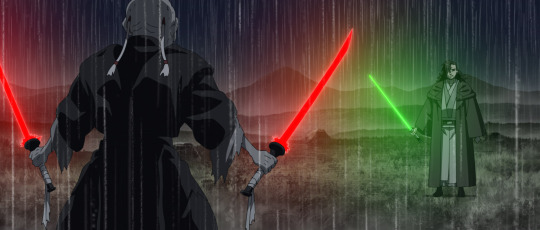
It sounded like there was a lot of freedom overall, with directors like Takanobu Mizuno (The Duel) asking "can you really do that with Star Wars?" Other than main characters that were off limits, were there any other concepts you had to turn away, or say ‘no, that's not Star Wars,’ or was it really kind of just letting them loose?
James Waugh: I think it was letting them loose. The process was in dialogue, so it wasn't that we sent them off with a framework and there wasn't a conversation and they kind of handed it back. We work at our best when we can have conversations about the values of Star Wars storytelling, or specifically, how can we make the story you're trying to tell more authentic to Star Wars? 'Hey, do you know that we have these things in the universe?' It was kind of an ongoing dialogue with the intention of facilitating their stories.
But yeah, there were definitely those moments of, like, 'are you guys really letting us do this?' (laughs) Yes, yes we are. That's the point! We want to figure this out, we want to make it work. As long as the stories have heart and soul I think we were happy.
Kanako Shirasaki: It was like, had anyone ever considered attaching two Star Destroyers into one? No, but…
That was a very TRIGGER thing to do.
Kanako Shirasaki: (laughs) Yeah.
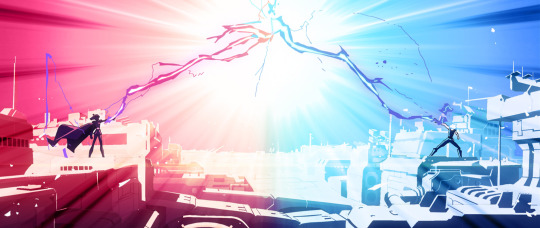
Anime has found a lot of success in these anthology-type stores, from The Animatrix to Batman: Gotham Knight and now Star Wars: Visions. What do you think it is about anime that makes it ideal for this style of storytelling?
Kanako Shirasaki: The first thing is, there are so many animators working in Japan who are trying to explore their own style. Studios trying to find their own style. I think there's already huge diversity in there, and maybe that really appeals to different creators around the world to want to explore and showcase these different art forms and styles of storytelling.
James Waugh: We knew very quickly that we wanted to show the breadth of the amazing different voices that are coming out of Japan. We didn't want to just be one note, in that way. So yeah, you're right, it does always seem to work with [those anthologies], but I mean it's purely because we wanted to see different people's perspective on Star Wars, and see the world-building that they would bring given the opportunity.
And now you can work a double Star Destroyer into the next movie.
James Waugh: Yeah, exactly. Someone's gonna try that, someone's gonna be inspired.
Star Wars: Visions launches today on Disney+.

-------
Joseph Luster is the Games and Web editor at Otaku USA Magazine. You can read his comics at subhumanzoids. Follow him on Twitter @Moldilox.
By: Joseph Luster
0 notes
Text
Exercise #1: Fiction
Please choose either option and write 250-500 words. Please email it to me at [email protected] by 8 pm Tuesday night. No attachments please (just copy it in the body of the email)!
A. In “The Other Place,” Mary Gaitskill interweaves the narrator’s past as a troubled teenager with his current life as a father to a potentially troubled son. Write a scene that weaves together a character’s past and present.
Some questions to think about while writing: What can we learn about someone from hearing certain details about their past? How does the past impact how they act in the present? How can you balance “flashbacks” with scenes in the present?
B. In “The Husband Stitch,” Carmen Maria Machado mixes retellings of folktales, fairytales, and horror stories with her own storytelling. Write a scene that incorporates a well-known story (in some capacity) into your own work.
Things to think about when writing: How can you take someone else’s story and make it your own? What balance do you need to strike between “retelling” and imagining your own narrative? What new meaning does an old story take on when you add it to yours?
Some Examples of Exercise #1--
Lost
My father and I were joined at the hip and that’s not to say I did not have a strong relationship with my mother because I did but as a young boy I only wanted to grow up to be just like my dad. I was halfway there and being the exact spitting image of him was evidence of that. His humor, confidence, and intelligence, were all things I deeply admired. Those special childhood moments are still engraved in my memory. When I was five we went to the annual summer fair as a family in our hometown of Connecticut. I remember riding atop his broad shoulders overlooking all the other kids and their parents. I would smack his balding head out of sheer amusement. All moments of utter delight. My father was very much a part of everything, from my first football catch to those first pedals on the bicycle unassisted. He was always right there and then he was gone. And here I am now.
At the age of sixteen, I am without him. A little over a year ago, my dad was fatally hit by a drunk driver on his way home from work. I have not stopped grieving since. Nothing is really worth doing if I can no longer receive his patented look of approval. “Good work, kid” was a common refrain from him after I had done things like get straight A’s. However, I have been acting out in school. My guidance counselor, Ms. Thompson, says I can still make him proud and I just don’t believe her. She thinks I’m depressed. I don’t say much of anything to my mother and I know she prays for me to get back to normal. I don’t know if that’s possible but she only looks at me now with pleading eyes in hopes that time will heal. I hope it can too but I can’t make any promises. My dad always told me to never make promises I couldn’t keep. I wish he were here now to teach me how to cope. He’d have the best advice and the irony in that is killing me. -Shajuana
---
Our dreams are a fantastical world where anything that you can make happen, can and will happen at will. Lucid dreaming gives you complete control over this temporary reality that exists only in your head, so long as your mind is in the right space. But what happens when your dreams of whimsy and magic become nightmares that warp your reality into the darkest sense of fear you can possibly imagine. Nightmares, like dreams, are portals to another world.
As a child, I remember being plagued with weeks of nightmares that were interrupted only by waning reprieves of dreams once or twice a week, if I was lucky. The saddest part is having your dream, the one that you are praying for, shift into a nightmare. In my case, I remember every dream I had would end the same way, by my walking through a neon, geometric, glowing figure that in one way or another, always seemed to fit perfectly into the dream world I currently inhabited. I’d walk through as a child, no older than 10, mesmerized by the colors and wind up in a dark, ashen laid field that sucked joy and emotion of my very being. Everything that normally existed to make a child’s life fun and joyful, was now just darkness with a sky that looked like a void.
But that was my childhood. As an adult, my life is going fantastic! I have a beautiful wife, my photography is thriving, and I have a second child on the way. Best part of all, I never have dreams anymore. Nothing in my life can be going better than it currently is, that is, until my first born, who is now about to be 10 in a week, told me about this dream he had where there was this an odd glowing shape in a field and before he could reach it, I woke him up for school. I thought nothing of it as the day wore on and eventually forgot all about it until the later that afternoon since I had a shoot with a client.
The client was a beautiful young woman hoping to make it big in the modelling industry, so we decided to go out to a cliff side that one end over looked a cliff and on the other, a beautiful flowery meadow. As we arrived, what had looked to be a promising day to shoot, no clouds in the sky, a beautiful sun shining to provide a whimsical glare on the lens, turned into a dark and dreary landscape with thunder and lightning arcing across the sky. Determined to get the shot of the day, I picked up my camera, put my face to the view finder and as I aimed it at the girl, a purple triangle appeared surrounding her, and what were once beautiful features, melted to a face of pure hatred and evil. Putting down my camera, shocked by what I saw, I was more shocked to realize that my childhood nightmare, had become my adult reality. -Xavier
---
Goldie was feeling very content by the roaring fire place. She stared at it and let the warmth wrap her like a blanket. She’d been very lucky finding the little cabin in the woods before it started snowing heavily. Not only that, but the family that was vacationing there were kind enough to make her feel right at home and safe. It was a place she could stay forever. It almost felt just right. Almost.
When Goldie had arrived, mom was making soup for her and her boys. She of course gave extra of her soup to Goldie, but Goldie did not find her soup option appealing. She looked at dad’s and the little boy’s and decided she wanted dad’s. She ate his soup and felt it was the right choice.
After dinner Goldie went into the living room to digest her dinner. The cabin had little scented candles that Goldie decided to light and the smell of pine and cinnamon apples took over. She noticed the couch had sleeping pillows and a comforter. It had been added for someone to sleep in. Goldie thought how lovely that one of them would give up their bed for her. She decided to sit in one of the chairs. Dad’s was too big, little boy’s was too small, but mom’s was the perfect fit. She felt the chair hugging her and the softness almost made her fall asleep right there.
When she decided it was time for bed she went to look for sleeping arrangements and new garments. She stepped over dad on the floor with the axe still in his head. She passed mom in the kitchen lying down with burnt skin from the hot soup. Goldie wondered if the soup would taste like mom. Sweet and naïve. She went to mom and dad’s room and took mom’s sleepwear. She felt the bed and it wasn’t quite what she was looking for. Then she went into little boy’s room. Goldie changed out of her clothes and noticed the dry blood all over her body. She decided she would clean herself later. But now she would sleep. Little boy was in bed, tied by the arm and ankles and Goldie crawled in. Goldie wrapped her arms around him and enjoyed the contrast of her relaxed muscles with his stiff body.“This is just right.” -Brenda
0 notes
Video
Video essay
Due to the limited time of video essay, some content will only be more specific in the script.
Script:
_Introduction_
_Background information on topic:
(Hi everyone, my name is Frank Lin and I am a 3D animation student.
Today, I'm gonna to talk a little bit about all 12 principles of animation and show you some example of that principles, and tell you why and how I used it in my work)
- Overall point of view of the topic + overview of components to be discussed:
I gonna take the part one of my voice over: this part (The 12 principles of animation were introduced by Disney’s animators, Ollie Johnston and frank Thomas in their book the illusion of life: Disney animation.
The 12 principles of animation were introduced by Disney’s animators, Ollie Johnston and frank Thomas in their book the illusion of life: Disney animation.
Published in 1981, it is widely considered to be the best animation book of all time.
1_SQUASH and STRETCH: Gives the illusion of weight and volume to a subject, and is often used of comical effect.
The object is squeezed by force, resulting in an elongated or flattened deformation, and the exaggerated expression makes the object itself look elastic, quality, and vital, so it is more likely to be dramatic.
2_ANTICIPATION: Prepares the audience for action, and increases realism of action. Sometimes used to heighten the suspense of a scene.
The action of the animated character must allow the audience to produce "expectation". Through the performance of the physical movement, the audience can predict the next action of the character, that is, let the audience be more integrated into the story.
3_ARCS: Humans and animals always move in arcs. Arcs increase the realism of the subject's action.
In the animation, basically all moving lines are parabolically except for mechanical movements. Therefore, when drawing moving lines, non-mechanical objects should not move completely in a straight line when moving. Mechanical objects use a stiffer linear motion, which makes it easier to distinguish between mechanical and non-mechanical objects, as well as the personality of these two completely different objects.
4_EASE IN and EASE OUT: The subject needs time to slow down and speed up. Drawings between two extreme poses provide the subject with greater realistic movement.
The general action is slower at the beginning and the end, the intermediate process is faster, because the general action is not equal speed movement, which is a general physical phenomenon. A stationary object starts to move slowly and quickly, and an object that is about to stop will slow down. If the motion starts or ends at the same speed, the viewer will feel the picture distortion.
5_APPEAL: Animated characters need to captivate audiences.Complicated character faces and lack of symmetry often make it difficult for audiences to connect.
Attraction is a necessary condition for any kind of art. Animation is like a movie. It contains many different art types. Whether it is music, pictures or plots, it must be matched with each other to interweave the best animation. works.The most appealing aspect of animation is the expression of an imaginative picture. Almost all animations are created by animators and directors. The performance of the animation can be full of imagination, so animation always gives people a feeling of magic, and is the most attractive place for animation.
6_TIMING: More frames create slower action, whilst fewer frames create faster action.
The soul of an animation is the movement of objects and characters, and the key to controlling movement is the rhythm of movement.
The rhythm of the action is about how fast is the speed. If it is too fast or too slow, it will make the action look unnatural, and different characters will have a different rhythm, because the rhythm of the action will affect the character's personality and affect the action. Natural or not.
Another key to controlling motion is mass, because all objects have different mass, and the rhythm can represent that for different object. It must be imaginative and must obey certain physical principles.
7_SOLID DRAWING: Adds weight, volume and 3D illusion to the subject.
The production of animation, visual performance accounts for a large part, and visual performance requires very solid painting skills. Whether it is making traditional animation or computer animation, animators need to have solid foundation training. Only a solid foundation can make a complex image be possible.
8_EXAGGERATION: Presents the physical features or elements of a character in exaggerated form.
Animation is basically an exaggerated way of performing, through the performance of the character, to make the sense more vivid .
Exaggeration is not just about expanding the range of motion, but by subtly and appropriately releasing the emotions that the character needs.
9_STRAIGHT AHEAD ACTION AND POSE TO POSE: Works for highly emotional and dramatized scenes. Involves drawing a few key frames for each action, followed by filling in the intervals.
Straight Ahead Action and pose to pose are two kinds of motion animation techniques. Straight Ahead Action is to start and edit the animation from the first frame to the last frame one by one in order, usually use to make a simple dynamic.
Pose to pose, the action is disassembled into some important freeze motions. After adding the intermediate complement animation, it produces a dynamic effect, usually for more complex movements.
10_STAGING: Communicates the primary mood, action or idea of a scene. Animators, Johnston and Thomas defined it as “the presentation of any idea so that is completely and unmistakably clear".
The animation is a massive work, because all the movements and composition of the animation need to be created by the animator's hand, so the composition, movement, and position in the animation need to be well organize to avoid too many trivial actions and changes at the same time. The most important thing is to arrange each lens and action. After that, the animation will look smoother and more perfect.
11_SECONDARY ACTION: Emphasizes and supports the primary action of the subject, whilst providing scenes with greater life.
The secondary action attached to the main action, although they are relatively minor movements, but actually very important. If the main action is a beautiful hand painting, the secondary action is the color on the picture. Not only can let the character be more vivid and real, but also make the character more alive.
12_FOLLOW THROUGH AND OVERLAPPING ACTION: Refers to parts of the subject that continue to move after a completed action. For example, the movement of a hand after an object has been throw.
Follow Through is to disassemble parts of the object. Usually, the parts without the skeleton are more likely to follow the movements, such as the tail of the animal, the hair, the tip of the clothes, and so on.
Overlapping Action is to disassemble the parts of the object, to shift the time of the action, to produce the time difference and exaggerated deformation of the separation, to increase the drama and expressiveness of the animation, to achieve the purpose of attracting the audience more easily, and to enhance the interest of the animation.
_conclusion_
-summary of main points of the body + restatement of main point of view:
(So this is all principles of animation, thank you Ollie Johnston, thank you frank Thomas, thank you so much Disney for your all wonderful principle of animation).
-evaluation: give my opinion through animation principle:
(Now we all know why we need to use this principles, I think this principles it’s like the soul of animation scenes).
0 notes
Text
Hyperallergic: The Vibrant Palette of Raghubir Singh’s India
Raghubir Singh, “Crawford Market, Bombay, Maharashtra” (1993),
photograph copyright © 2017 Succession Raghubir Singh
Something apparently minor but revelatory happened when I was with Raghubir Singh in Mumbai (when it was still called Bombay) in the early 1990s. We were in a fascinating place called ‘The Crawford Market,” a vast compendium of stalls filled with local produce. Wherever you looked there were spectacular things to see. (I define “spectacle” as a sight unusually rewarding to the eye.) I was excited by all the action; Raghubir, on the contrary, seemed utterly calm.
Suddenly, the revealing thing happened. He whipped his 35mm camera up to his eyes, and snapped it, apparently without having taken stock of the scene itself. There had been no pause for judgment or framing, and no duration in the taking of the picture. The moment was over, as it seemed, before it had begun.
How often have we heard about the stealth of street photographers, their agility, the speed of their varied attentions? Raghubir was of their breed, but faster still, and I think, for good reason. He had to reconcile his need for the most precise depth of field with his use of the slowest but most fine-grained of films, Kodachrome 25. To extend his lapidary focus from the nearest plane to the farthest out, he had to narrow the aperture of the lens. To reckon with the available light, he had to compensate by lengthening the time of exposure, which endangers any image to the hazards of wobble and blur. What I had seen that day at the market was the steadiest grip, capable of holding its operations absolutely firm for a period as improbably lengthy as a sixtieth of a second. The photographer himself was blasé about this skill, which enabled him to do justice to the most layered and dense figurations of his Indian homeland.
Raghubir Singh,
“Man Diving, Ganges Floods, Benares, Uttar Pradesh” (1985), photograph copyright © 2017 Succession Raghubir Singh
Speaking of them, at some other point, I remember asking him if he were ever fatigued by the inexhaustible exoticism of his subjects. For Raghubir, the exotic would be some small town in Ohio or Iowa. The dictionary defines “exotic” as “of foreign origin or character, not native, introduced from abroad but not fully naturalized or acclimated.” “Exotic” requires some psychic distance, some feeling of “otherness,” perceived by the viewer. The adjective often implies a source of attraction but not necessarily of approval, depending on those involved.
I can’t help quoting Susan Sontag on this subject: “The camera makes everyone a tourist in other people’s reality, and eventually in one’s own.” This remark stems from the 1970s, when some writers took an adversarial approach to what they assumed to be the colonizing drive of Western photographic culture. Superior technology — so goes the argument — induces a stereotypical overview of unfamiliar lives, leaving them in false, submissive categories. When I suggested to Raghubir, in an interview, that his publishers were packaging his work as appropriate for tourist appetites, he replied that such a notion “has nothing to do with me. I mean, I grew up in India. My basic education has been in India […] I would be out of my mind to see [my work] as travel photography. I think the notion of travel photography […] means passing through.”
But to be a tourist in one’s own reality, as Sontag suggests, is a statement that goes too far in its implication of a self-deceiving mindset on a superficial journey to visit itself. On the contrary, this kind of trip might just unmask the familiar by revelation of the exotic that lies within.
Raghubir Singh, “Ganapati Immersion, Chowpatty, Bombay, Maharashtra” (1989),
photograph copyright © 2017 Succession Raghubir Singh
Also, I have never thought that the term “tourist photography” was derogatory — we have museums that literally tour us through investigations of our past and present, and even sponsor trips to foreign lands. Photography incarnates that impulse to travel, documents and legitimates it as an agent of our existential wonder, by virtue of its great pictorial capacity. I view Raghubir’s career as knowingly in the service of that wonder —and as a creative extension of it — relayed out to his own background.
Interestingly, as his art got underway in the 1960s and ‘70s, a new documentary impulse was energizing American photography. He had significant contacts with it, personally and professionally. But even before he became acquainted with some of its innovational figures — Lee Friedlander and Garry Winogrand — he’d been working on assignment for National Geographic, and had been influenced by Life magazine telephoto reportage. These were useful outlets for him to learn his craft, as well as idioms worth rejecting on behalf of his art.
In order to explore Indian lives, he could employ Life’s monumental pictorialism and mix it with the expansiveness of the new documentarians. Nor should we forget that Raghubir, a student of photographic history, admired Henri Cartier Bresson and was sympathetic to the Magnum Agency’s blend of aesthetic self-consciousness and journalistic responsibility. Charged up with this mélange of genres, he set out on a path that would lead him to become the visual poet laureate of the subcontinent.
Raghubir Singh, “Monsoon Rains, Monghyr, Bihar” (1967),
photograph copyright © 2017 Succession Raghubir Singh
This happened within the nominal mode of street photography, an aspect of which has not been well understood. Since the invention of the camera, scholars have long taken note of the dialogue between painters and photographers. These cultural workers most evidently converged at that moment in time dominated by the movement called Realism. Photography appealed to realist sensibility by virtue of its seeming ownership of material appearances. Of course painting had the higher status in this conversation, since it could rely on its prestige as freely created vision, whereas photography offered only a mechanical copy of outer worlds. Useful as this was in the acquisition of knowledge, the copy was considered inferior or at best only a handmaiden to imaginative art.
The inevitable next step in the weakening interaction between the two media came with the advent of modernism. Painting’s retreat from, or dismissal of, material appearances became one of its cardinal traits. And let’s not overlook another casualty produced in general by modern art: its demotion of story content in painting, even representational painting, later marginalized by abstraction. Viewers were prompted to search for internal conceptual meanings rather than for illustrational clues to behavior in likely schemes of cause and effect.
The many practices in photography were, by contrast, invested in such schemes, reflected by their specific social utility. Group portraiture, political reportage, wedding pictures, combat photography, etc., are genres we know very well. They shuffle us around the world in mundane narrative containers, most often accompanied by textual fill-in. Certain questions were answered: who was there, for what purpose, and on what date? We also might learn about the doings that preceded or succeeded the scenes at issue, of which these pictures represent an instance, whether central or incidental.
Raghubir Singh, “Victoria Terminus, Bombay, Maharashtra” (1991), photograph copyright © 2017 Succession Raghubir Singh
Not so street photography! In characteristic examples of its kind, the view is populated with incidentals and the discursive context acts as mere caption, at best. There tends to be a notion of continuities active beyond the frame, as important in their absence as whatever presences are shown within it. There is no necessary appointment between the picture makers and their motifs. Street photographers enjoy wide latitude in this respect. It’s up to them, at the moment or in retrospect, to determine a picture’s worthiness of being released to a public. In other words, they themselves initially decide if the work is expressive enough of their concerns to warrant being attached to their names. No wonder that photographers with artistic ambitions were drawn to the street genre. Its openness to capricious possibilities becomes an incentive to workers unwilling to tell stories and yet be still highly engaged with the world. They are lyrical opportunists, caught up with the challenge of finding memorable nuance in the psychology of space, or in the moody atmosphere of their own feelings, or even in the tension of being stared back by their subjects. There is no story line to such observations, snatched from multiple, program-free proceedings. They are understood as things that simply happen. You could say that photographers who range this way are modernists without portfolio.
I hope I’m not being presumptuous by fitting Raghubir Singh into this idiom. True enough, he has his own named territories and stated themes, which he often introduced by writing serious historical and social essays to accompany them. None of his readers would escape the impression that he had an investigative regard for his material. He was not playing around in the hope of finding weird, floating anomalies, like his American colleagues. But he brought to his work an element that helped to change the temper of street photography to come. And by that I mean color.
Raghubir Singh, “Boy at Bus Stop, New Delhi” (1982), photograph copyright © 2017 Succession Raghubir Singh
There was once a period when you could cite grievances that certain photos were “about” color, although never would you hear that a photograph was about black-and-white. We now look back upon black-and-white photography as a pictorial report of situations and relationships that occurred in the irrevocable past. This retrospection is not caused by decreased use of the medium but rather because its gray scheme contracts sensory recall, like memory does, fading across time. A kind of melancholy arises from this encounter, often suitable to evidently sad situations. Thus, when I first saw the color pictures of the American Depression by FSA photographers Russell Lee and Jack Delano, I was shocked by their charming, pastel tints: in cases like these, color can very well have its own narrative impact that transgresses received notions of emotional proprietary.
In Raghubir’s case, color functions as the core illumination of his great surveys. He was able to take immediate advantage of strong, varied palettes because they were inherent in his subjects’ presentation to themselves and to the world. No matter what misery might be evident, the ensemble could still be very decorative and upbeat if permeated by religious fervor. By recognizing color’s ability to moisten a scene at the point of the spectator’s contact with it, the photographer often manages to suggest that time is extended, from the antiquity of ritual to the “now” of the present moment. The epic and the intimate cohabit in his books, each of them adorned by the peacock flutterings at their turfs.
The exultation of these Indian sagas reminded me of a high point in my own experience: years ago, I used to jog through Southern Manhattan, playing a tape of a great romantic symphony in on my Walkman cassette player. How to synchronize the elated entrance of the soprano in the last movement with the highpoint of my exercise: the apex of the runway on the Brooklyn Bridge? In hindsight, I should have realized that this reach for the sublime was anticipated by the sound of a little click in a Bombay market.
Raghubir Singh’s work is currently on view in Modernism on the Ganges: Raghubir Singh Photographs at the Metropolitan Museum of Art (1000 Fifth Avenue, Upper East Side, Manhattan), which will continue through January 2, 2018.
The post The Vibrant Palette of Raghubir Singh’s India appeared first on Hyperallergic.
from Hyperallergic http://ift.tt/2lTXG1K
via IFTTT
0 notes